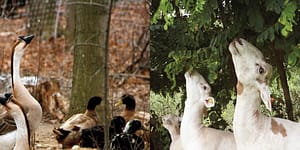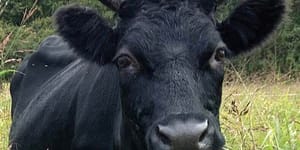Enter Biochar: Reduce Your Pet’s Carbon Pawprint

Many carbon-conscious pet owners are aware of the non-recyclable waste that comes with owning a pet. Between kitty litter, puppy pads, and all those plastic dog bags, the waste adds up. Enter biochar.
Imagine a world where the puppy pad is so odorless that your dog wants to sleep on it and the kitty litter box isn’t SO nauseating. Turns out, that future isn’t so far off, we just need to introduce a couple creative biochar solutions into our pets’ lives!
The following is an excerpt from Burn, by Albert Bates and Kathleen Draper. It has been adapted for the web.
Pets and Biochar
Few things are as exciting or exhausting as a new puppy. Kathleen can only think of two: raising children and being on the ground floor of the nascent biochar industry. Not satisfied with only two of these in her life, she decided that three exciting, exhausting outlets is really what she needed to make her life completely crazy. Enter a 2.5-pound (1.1 kg) Pugzu puppy. In an effort to housebreak (interesting word for it) the new family member, she began researching all sorts of ridiculous inventions, such as the elegantly named “wee wee pads.” But the thought of adding doggie diapers to garbage mountains started keeping her up at night. Of course, that could have just been the puppy.

She slept better having figured out how to combine two of the three exciting yet exhausting things in her life, and the next day she purchased a roll of biodegradable landscaping fabric and sewed up three sides. Inside she added a few pounds of a biochar-vermicompost mix she had sitting around and sewed up the top. Since some of the finer particles of char can escape this type of fabric, she put the pad in a low box so it wouldn’t make a mess on the floor.
While it took awhile for the puppy to figure things out, eventually she started to use the Terra Pee Pad for its intended use and more. Kathleen could detect zero odors after several deposits. Not too surprising, given what we know about biochar, but what is surprising is that the canine nose had no issues with it, either. The puppy didn’t just pee on the pad, she slept on it, too. Kind of gross, Kathleen thought, but kind of interesting, too.
In reading up on the contents of dog urine (ever a fascinating subject), and how destructive it can be to lawns (unless you like the polka dot look) and urban trees, it occurred to Kathleen that homeowners might want to create a little Terra Pee sandbox for dogs to conduct their business in, lined with a similar Terra Pee Pad that could eventually be cascaded to garden use. And for those poor peed-upon trees doggies tend to favor, how about a Terra Pee Pad skirt for the trunk so trees don’t overdose on nitrogen, but instead take it in more gradually?
Cats, too, can benefit from a carbon cascade. The feline footprint, when it comes to carbon, can be a shocker, litter-ally!
Consider this: Most of the 2.6 million tons of kitty litter sold in the United States every year is made from bentonite clay. That is 12 percent of the 21.2 megatons of global bentonite mining that contributes 118,000 tons of CO2-e to climate change each year as bentonite mining expands 2 to 4 percent per year.1 To picture that amount of material, imagine nearly a quarter of a million dump trucks carting away clay after first blowing the tops off Wyoming mountains.

Now imagine, as Jonah Levine of Confluence Energy has, that a large portion of that bentonite can be displaced with high-carbon, woody bio- char made from beetle-killed forests in Colorado or pallet waste. In the right combination, a pelletized biochar-based kitty litter is lightweight, highly absorbent, and controls odors—an appealing trifecta to consumers. Even better, when spent it can be composted instead of landfilled. But even if sent to a landfill, it would sequester 9.5 million tons of CO2 per year (assuming 1:1 substitution for clay kitty litter).
Few would have guessed the market for biochar for use in cat litter would be one of his largest.
Recommended Reads
Recent Articles
Have you heard of silvopasture? This system of managing grazing animals is an ancient practice that integrates trees and pasture into a single system for raising livestock. These systems are managed for both forest products and forage, providing short-and long-term income sources in a mutually beneficial way for healthier animals, better soil, less pest control and mowing, and…
Read MoreOxeye daisies are one of the most important plants for pollinators including beetles, ants, and moths that use oxeye daisies as a source of pollen and nectar. Instead of thinking about removing a plant like oxeye daisy, consider how you can improve the fertility and diversity of habitat resources in your home landscape, garden, or…
Read MoreIn her book, The Art of Science and Grazing, nationally known grazing consultant Sarah Flack identifies the key principles and practices necessary for farmers to design, and manage, successful grazing systems. This book is an essential guide for ruminant farmers who want to crate grazing systems that meet the needs of their livestock, pasture plants,…
Read MoreThis long-lived perennial legume is used for forage and erosion control. Kudzu is edible with many medicinal uses and other applications. Pollinators of all kinds love its prodigious lavender blooms!
Read MoreMove aside, maple! We have two new syrups to add to the table. Read on for insights on tapping, selling, and eating syrup from walnut & birch trees.
Read More








